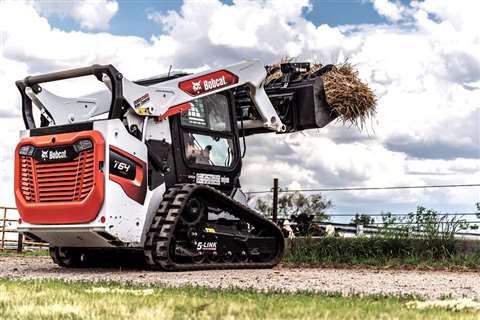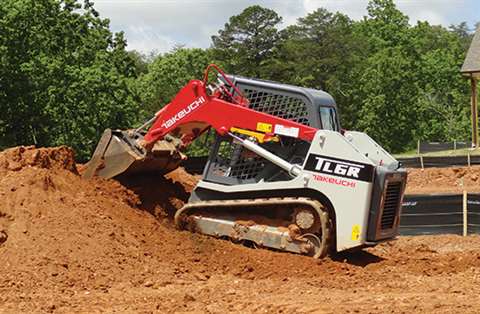Trendlines: Another look at the compact track loader boom
02 March 2023
 By 2021, compact track loaders were outselling skid-steer loaders three to one. (Photo: Bobcat)
By 2021, compact track loaders were outselling skid-steer loaders three to one. (Photo: Bobcat)
Compact track loaders (CTLs) are relatively new in the construction world, a business which can be characterized as conservative when it comes to which equipment it buys. But in the last decade, the popularity of these machines has skyrocketed and they are by far the best-selling equipment type in North America.
The first CTLs were developed in the 1980s. Takeuchi claims to have been the first to make such a machine, while in North America, ASV (acquired by Yanmar in 2019) was an early pioneer.
Many of the long-line OEMs and compact equipment specialists jumped onboard with the concept in the late 1990s and early 2000s, but uptake stalled with the sub-prime crisis in the mid-2000s, which was followed by the global financial meltdown.
CTLs started to take root as the equipment industry got back on its feet in the early 2010s. Since then, as residential construction has recovered, the market has gone to the stars. In 2015, CTLs outsold their wheeled equivalent, the traditional skid-steer loader, for the first time. As the residential market boomed in the pandemic years, their popularity grew even more steeply, and by 2021, CTLs were outselling skid steers three to one.
A 10-year rise to such heights might sound like a slow burn, but in the construction equipment world, where machine preferences change at a glacial pace, this is as close to lightning-fast as it gets.
Reasons behind the rise
Although more expensive to buy and maintain than the equivalent skid-steer loader, the tracked variant has the advantage of exerting much lower ground pressure. This makes it a better performer in off-road conditions, both in terms of crossing the terrain and in pushing performance. It’s also less likely to damage the ground. A tracked undercarriage can also mean greater operator comfort and less fatigue due to whole body vibration (WBV), particularly following the introduction of more sophisticated suspension designs by a number of manufacturers in the late 2010s.
These performance and comfort advantages helped to open up new applications in grounds care and landscaping as well as replacement of the skid-steer in traditional applications.
Read more: Skid-steer market is aging well
 Bill Baker, vice president, Off-Highway Research in North America
Bill Baker, vice president, Off-Highway Research in North America
As much as new applications have helped, the boom in residential construction since mid-2020 has been the main driver. Combined sales of skid steers and CTLs rose 20% in 2020, followed by a further 12% increase in 2021. This took total sales to an unprecedented 125,660 units in 2021, comprising 97,647 CTLs and 28,013 skid-steer loaders.
The U.S. accounted for 86% of the North American market in 2021, with Canada representing 15%. Across the region, the split between CTLs and skid-steer loaders was 78-22. Relatively speaking, skid-steer loaders are slightly more popular in Canada, where the split was 76-24, whereas in the U.S. the split was 78-22.
As far as demand, sales of CTLs look to be at – or just past – the high-tide mark. The inflationary environment and rise in interest rates are slowing residential construction. Despite that, backlogs remain so high that suppliers should still enjoy good sales in 2023 as they fulfill the business on their order books.
Bill Baker is vice president of Off-Highway Research in North America. OHR is a market research and forecasting business specializing in analysis of the global construction and agricultural equipment markets. Formed in 1981 as part of The Economist Intelligence Unit (EIU), it is now the largest consultancy of its kind in the world, with offices in Chile, China, Germany, Japan, India, the U.K. and the U.S. OHR is part of the KHL Group.
As popular as they are in North America, compact track loaders sell in extremely small numbers elsewhere in the world. The next biggest market is Europe, where only about 2000 CTLs (and 3500 skid steers) sell each year – more than half of which are sold in Italy. In most other countries, you can count the number of CTL sales on the fingers of one hand.
 The popularity of CTLs in the region led Takeuchi to start North American production in 2022. (Photo: Takeuchi)
The popularity of CTLs in the region led Takeuchi to start North American production in 2022. (Photo: Takeuchi)
But the popularity of CTLs in North America, and the fact that the region is still by far the largest skid-steer loader market in the world, is a positive foreign direct investment in North American manufacturing.
North America represents more than 80% of global demand for skid steers and more than 90% of demand for CTLs. It is therefore not surprising that the majority of machines sold in the region are manufactured here.
Indeed, the rise in popularity of CTLs in North America over the last decade, along with the fall in popularity of skid-steer loaders in Europe, has seen production of these machines migrate to the U.S. JCB and Wacker Neuson are examples of two companies which have shifted production in this way. That trend has continued more recently with the two major importers, Kubota and Takeuchi, starting up North American production in 2022, in Salina, Kan., and Moore, S.C., respectively.
STAY CONNECTED



Receive the information you need when you need it through our world-leading magazines, newsletters and daily briefings.
CONNECT WITH THE TEAM







